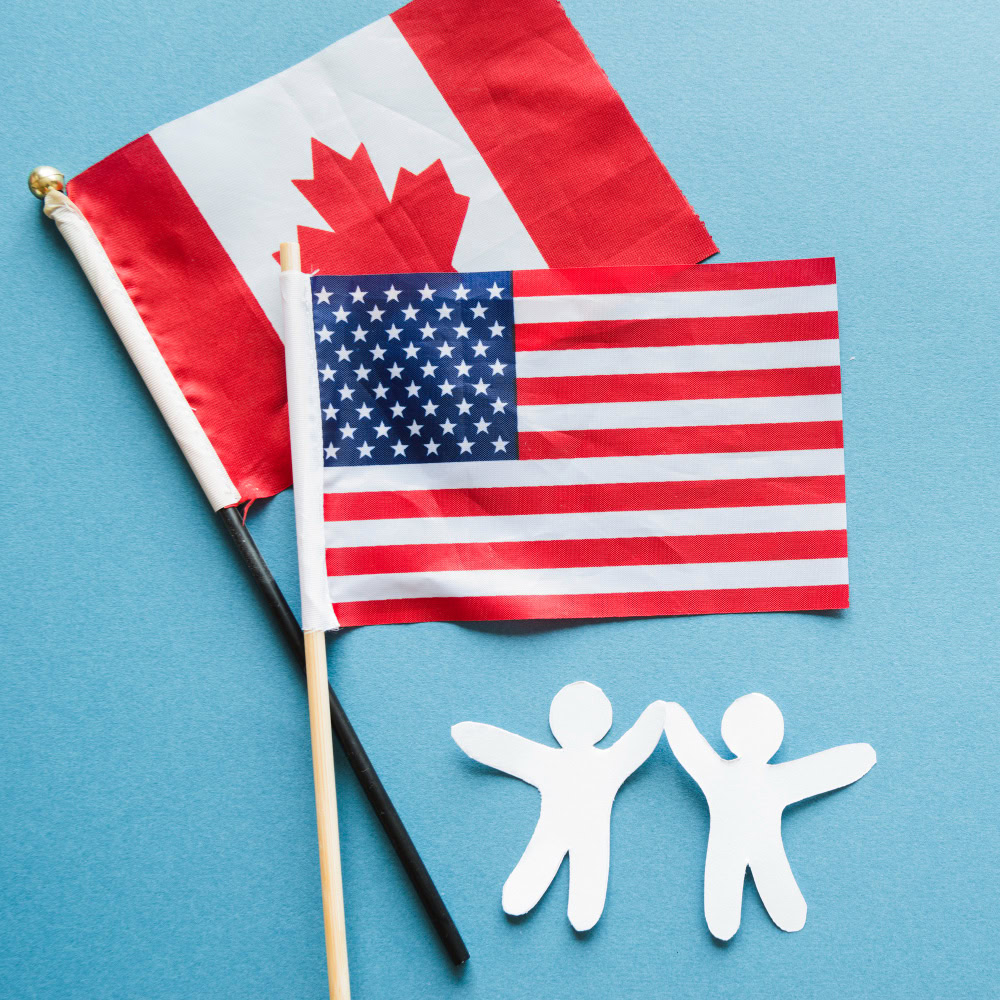Is Canada Bigger Than the US?
Is Canada larger than the US? This perennial issue frequently ignites passionate discussions about the two major North American neighbors—the USA and Canada. The answer may surprise you. Most people assume the US is larger due to its population and global influence.
This is not just a curious question; it has the potential to provide additional insight into the geography, resources, and personalities of these enormous countries. So, just how massive are we talking about with each country? Let’s break it down. Maps can sometimes distort perceptions of country sizes, making Canada appear even larger than it is.
Canada vs. United States: A Geographic Contrast
When it comes to size, Canada is slightly larger than the United States of America. It ranks as the second largest country in the world in terms of total area, with about 9.98 million square kilometers, following Russia. The United States, which comes third globally, occupies approximately 9.83 million square kilometers and extends from Alaska in the north to Hawaii in the south.
Canada is surrounded by three oceans — the Pacific Ocean, the Atlantic Ocean, and the Arctic Ocean — giving it the longest shoreline in the world, measuring approximately 151,473 miles. The country boasts a huge number of lakes, including the largest lake entirely within Canada, Great Bear Lake, and shares the Great Lakes with the United States. If you are wondering how many lakes are in Canada, the answer is that there are over two million lakes, which is more than any other country in the world. In fact, there are millions of lakes worldwide, but Canada’s lakes make up a significant portion of the planet’s freshwater. These water bodies contribute significantly to Canada’s impressive water area, which is larger than that of the US and even greater than the total land area of France. Canada’s vast water area and national parks are key features of its national identity.
Canada’s diverse natural landscapes include arctic tundras, mountains, forests, and vast rivers. The largest province by area is Quebec, covering over 1.5 million square kilometers, while Nunavut is the largest territory, spanning more than 2 million square kilometers. Ontario is the most populated province in Canada. Among the provinces, Alberta and Saskatchewan are the two landlocked provinces. The country also features notable islands such as Ellesmere Island and Baffin Island, the latter being the largest island in Canada and the fifth largest island on Earth.
On the other hand, although marginally smaller in total area, the United States has a larger actual land area than Canada. The US land area is approximately 9,148,000 square kilometers, compared to Canada’s land area of about 9,094,000 square kilometers. The US also has a diverse range of climates and topographies, from the deserts of Arizona to the forests of British Columbia and the mountains of Alaska. For comparison, British Columbia is larger than both the United Kingdom and the Republic of Ireland.
Water Features: Lakes, Rivers, and Coastlines
Canada’s reputation as a huge country is closely tied to its remarkable water features, which set it apart from other nations in both scale and diversity. With more than two million lakes scattered across its ten provinces and three territories, Canada holds the distinction of having the most lakes of any country in the world. These lakes cover about 8% of the land area of Canada, offering a stunning picture of natural abundance. Among them, Great Bear Lake stands out as the largest lake entirely within Canada, spanning approximately 12,028 square miles. Meanwhile, Lake Superior, shared between Canada and the United States, is the largest of the Great Lakes and one of the largest freshwater lakes in the world, covering around 31,700 square miles.
The country’s water area is a defining feature of its geography. Canada’s total area is about 3.9 million square miles, making it the second-largest country in the world after Russia. Of this, nearly 891,000 square miles are water—an impressive figure that highlights the importance of lakes, rivers, and coastlines in shaping the land area of Canada. This extensive water area is a key reason why, when you compare Canada and the United States, Canada is considered the larger country by total area, even though the US has a slightly larger land area.
Canada’s coastline is another record-breaker, stretching over 151,000 miles and bordering three oceans: the Pacific Ocean, the Atlantic Ocean, and the Arctic Ocean. This gives Canada the longest shoreline in the world, a feature that not only defines its geography but also supports a rich diversity of marine life and ecosystems. The provinces and territories, from British Columbia’s rugged Pacific coast to the icy shores of the Arctic, offer countless opportunities for exploration and adventure.
Rivers are equally significant in Canada’s landscape. The Mackenzie River, for example, is one of the longest rivers in the country, flowing through the Northwest Territories and connecting remote regions to the Arctic Ocean. Across the provinces, rivers have played a vital role in shaping settlement patterns, supporting wildlife, and providing resources for communities.
When comparing the two countries, it’s clear that Canada’s water features are more extensive than those of the United States. While the US has a larger population and a more developed economy, Canada’s vast lakes, rivers, and coastlines make it a unique destination for nature lovers and a crucial player in global environmental conservation. British Columbia, for instance, is renowned for its breathtaking coastline and abundant freshwater resources, attracting visitors from around the world for activities like kayaking, fishing, and hiking.
The differences between Canada and the United States in terms of water area and natural features are significant. While the US may have a slightly larger land area, Canada’s total area, bolstered by its immense water resources, secures its place as the larger country. This distinction is important for understanding the unique environmental and cultural landscapes of both nations.
In summary, Canada’s lakes, rivers, and coastlines are not just geographical features—they are central to the country’s identity as one of the largest and most beautiful countries in the world. From the thunderous spectacle of Niagara Falls to the serene expanse of Great Bear Lake and the wild shores of British Columbia, Canada offers endless opportunities to experience the wonders of nature. Whether you’re interested in exploring the great lakes, learning about the differences between the two countries, or simply enjoying the vastness of Canada’s land and water, there’s something here for everyone.
Population and Immigration
Canada has a much smaller population than the US, with about 38 million people compared to over 330 million in the United States. The US has more people, even though both countries have similar land sizes. Most Canadians live within 160 kilometers of the US border, near major city centers like Toronto and Montreal, as well as Ottawa, Calgary, and Edmonton. Unlike the United States, where the population is more evenly distributed, the rest of Canada’s vast northern regions are less hospitable and sparsely populated.
Canada’s immigration policies, including the Express Entry system and provincial nomination programs, are designed to attract skilled workers to support economic growth and address demographic challenges. The country’s immigration laws emphasize humanitarian immigration and family reunification.
The United States, with its larger population, has a more complex immigration system that includes family-based immigration, employment visas like the H-1B, and the Diversity Visa Lottery. The US offers many economic opportunities for immigrants, especially in major cities and states such as California, Florida, and New York.
Healthcare and Economic Opportunities
Healthcare systems differ significantly between the two countries. Canada offers universal healthcare funded by taxes, providing essential medical services for free to residents. In contrast, the US has the highest healthcare costs globally, with access often tied to employment and private insurance, leading to disparities in healthcare availability. Recently, there has been a rise in healthcare costs and inflation in the US, making affordability a growing concern.
Economically, Canada benefits from abundant natural resources such as minerals, lumber, fossil fuels, and a strong service sector including banking, real estate, and technology. The US economy is one of the largest and most dynamic globally, offering vast opportunities across various industries. In both countries, people can find ways to save money or benefit financially through smart spending, invest, and employment opportunities.
Additional Comparisons: Canada vs. Australia
Australia, another large country, is smaller than Canada in terms of land area, measuring about 7.69 million square kilometers. Both countries use points-based immigration systems to attract skilled labor and have similar demographic distributions concentrated in coastal areas.
Conclusion
So, is Canada bigger than the US? In terms of total area, including water, Canada is slightly larger. However, when comparing actual land area, the United States is bigger. Both countries share the longest undefended border in the world and have unique geographic and demographic characteristics.
For those considering immigration, factors like quality of life, economic opportunities, and immigration laws may be more important than size alone. Whether you plan to visit or move to Canada or the United States, understanding these differences can help you make informed decisions.





